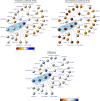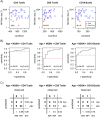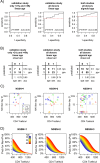Highly Predictive Model for a Protective Immune Response to the A(H1N1)pdm2009 Influenza Strain after Seasonal Vaccination
- PMID: 26954292
- PMCID: PMC4782986
- DOI: 10.1371/journal.pone.0150812
Highly Predictive Model for a Protective Immune Response to the A(H1N1)pdm2009 Influenza Strain after Seasonal Vaccination
Abstract
Understanding the immune response after vaccination against new influenza strains is highly important in case of an imminent influenza pandemic and for optimization of seasonal vaccination strategies in high risk population groups, especially the elderly. Models predicting the best sero-conversion response among the three strains in the seasonal vaccine were recently suggested. However, these models use a large number of variables and/or information post- vaccination. Here in an exploratory pilot study, we analyzed the baseline immune status in young (<31 years, N = 17) versus elderly (≥50 years, N = 20) donors sero-negative to the newly emerged A(H1N1)pdm09 influenza virus strain and correlated it with the serological response to that specific strain after seasonal influenza vaccination. Extensive multi-chromatic FACS analysis (36 lymphocyte sub-populations measured) was used to quantitatively assess the cellular immune status before vaccination. We identified CD4+ T cells, and amongst them particularly naive CD4+ T cells, as the best correlates for a successful A(H1N1)pdm09 immune response. Moreover, the number of influenza strains a donor was sero-negative to at baseline (NSSN) in addition to age, as expected, were important predictive factors. Age, NSSN and CD4+ T cell count at baseline together predicted sero-protection (HAI≥40) to A(H1N1)pdm09 with a high accuracy of 89% (p-value = 0.00002). An additional validation study (N = 43 vaccinees sero-negative to A(H1N1)pdm09) has confirmed the predictive value of age, NSSN and baseline CD4+ counts (accuracy = 85%, p-value = 0.0000004). Furthermore, the inclusion of donors at ages 31-50 had shown that the age predictive function is not linear with age but rather a sigmoid with a midpoint at about 50 years. Using these results we suggest a clinically relevant prediction model that gives the probability for non-protection to A(H1N1)pdm09 influenza strain after seasonal multi-valent vaccination as a continuous function of age, NSSN and baseline CD4 count.
Conflict of interest statement
Figures





Similar articles
-
Relation of activation-induced deaminase (AID) expression with antibody response to A(H1N1)pdm09 vaccination in HIV-1 infected patients.Vaccine. 2013 Apr 26;31(18):2231-7. doi: 10.1016/j.vaccine.2013.03.002. Epub 2013 Mar 14. Vaccine. 2013. PMID: 23499520
-
Pandemic influenza A(H1N1)pdm09 improves vaccination routine in subsequent years: a cohort study from 2009 to 2011.Vaccine. 2013 Jan 30;31(6):900-5. doi: 10.1016/j.vaccine.2012.12.002. Epub 2012 Dec 16. Vaccine. 2013. PMID: 23246546
-
Pre-vaccination immunity and immune responses to a cell culture-derived whole-virus H1N1 vaccine are similar to a seasonal influenza vaccine.Vaccine. 2012 Jun 22;30(30):4543-51. doi: 10.1016/j.vaccine.2012.03.061. Epub 2012 Apr 1. Vaccine. 2012. PMID: 22475864 Clinical Trial.
-
Key points in evaluating immunogenicity of pandemic influenza vaccines: A lesson from immunogenicity studies of influenza A(H1N1)pdm09 vaccine.Vaccine. 2017 Sep 18;35(39):5303-5308. doi: 10.1016/j.vaccine.2017.07.092. Epub 2017 Aug 4. Vaccine. 2017. PMID: 28784284 Review.
-
Pandemic influenza H1N1 2009, innate immunity, and the impact of immunosenescence on influenza vaccine.Yale J Biol Med. 2009 Dec;82(4):143-51. Yale J Biol Med. 2009. PMID: 20027279 Free PMC article. Review.
Cited by
-
CD3 downregulation identifies high-avidity, multipotent SARS-CoV-2 vaccine- and recall antigen-specific Th cells with distinct metabolism.JCI Insight. 2024 Jan 11;9(4):e166833. doi: 10.1172/jci.insight.166833. JCI Insight. 2024. PMID: 38206757 Free PMC article.
-
Reevaluation of immune activation in the era of cART and an aging HIV-infected population.JCI Insight. 2017 Oct 19;2(20):e95726. doi: 10.1172/jci.insight.95726. JCI Insight. 2017. PMID: 29046481 Free PMC article.
-
The use of cell-mediated immunity for the evaluation of influenza vaccines: an upcoming necessity.Hum Vaccin Immunother. 2019;15(5):1021-1030. doi: 10.1080/21645515.2019.1565269. Epub 2019 Feb 20. Hum Vaccin Immunother. 2019. PMID: 30614754 Free PMC article. Review.
-
Improving Vaccine-Induced Immunity: Can Baseline Predict Outcome?Trends Immunol. 2020 Jun;41(6):457-465. doi: 10.1016/j.it.2020.04.001. Epub 2020 Apr 8. Trends Immunol. 2020. PMID: 32340868 Free PMC article. Review.
-
Age dependent differences in the kinetics of γδ T cells after influenza vaccination.PLoS One. 2017 Jul 11;12(7):e0181161. doi: 10.1371/journal.pone.0181161. eCollection 2017. PLoS One. 2017. PMID: 28700738 Free PMC article.
References
-
- WHO | Influenza (Seasonal). World Health Organization. Available: http://www.who.int/mediacentre/factsheets/fs211/en/.
-
- A revision of the system of nomenclature for influenza viruses: a WHO memorandum. Bull World Health Organ. 1980;58: 585–91. Available: http://www.pubmedcentral.nih.gov/articlerender.fcgi?artid=2395936&tool=p.... - PMC - PubMed
Publication types
MeSH terms
Substances
LinkOut - more resources
Full Text Sources
Other Literature Sources
Medical
Research Materials

